2014 SUBARU BRZ air condition
[x] Cancel search: air conditionPage 338 of 488
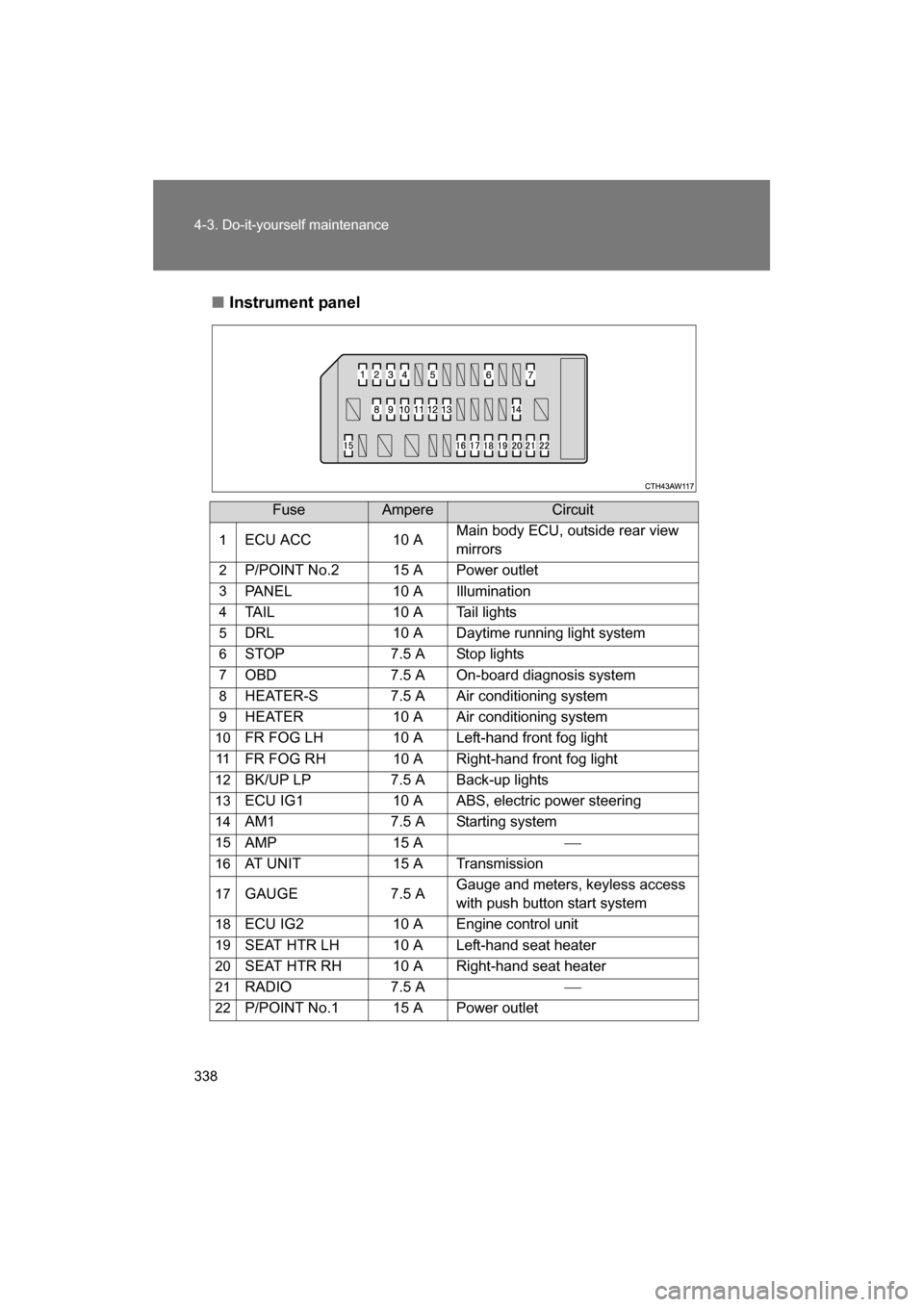
338
4-3. Do-it-yourself maintenance
■Instrument panel
FuseAmpereCircuit
1 ECU ACC 10 A Main body ECU, outside rear view
mirrors
2 P/POINT No.2 15 A Power outlet
3 PANEL 10 A Illumination
4 TAIL 10 A Tail lights
5 DRL 10 A Daytime running light system
6 STOP 7.5 A Stop lights
7 OBD 7.5 A On-board diagnosis system
8 HEATER-S 7.5 A Air conditioning system
9 HEATER 10 A Air conditioning system
10 FR FOG LH 10 A Left-hand front fog light
11 FR FOG RH 10 A Right-hand front fog light
12 BK/UP LP 7.5 A Back-up lights
13 ECU IG1 10 A ABS, electric power steering
14 AM1 7.5 A Starting system
15 AMP 15 A
16 AT UNIT 15 A Transmission
17 GAUGE 7.5 A Gauge and meters, keyless access
with push button start system
18 ECU IG2 10 A Engine control unit
19 SEAT HTR LH 10 A Left-hand seat heater
20 SEAT HTR RH 10 A Right-hand seat heater
21 RADIO 7.5 A
22 P/POINT No.1 15 A Power outlet
Page 364 of 488

364
5-1. Essential information
If you think something is wrong
If you notice any of the following symptoms, your vehicle probably
needs adjustment or repair. Contact your SUBARU dealer as soon as
possible.
■Visible symptoms ●Fluid leaks under the vehicle
(Water dripping from the air conditioning after use is normal.)
● Flat-looking tires or uneven tire wear
● Engine coolant temperature gauge needle continually points
higher than normal
■Audible symptoms ●Changes in exhaust sound
● Excessive tire squeal when cornering
● Strange noises related to the suspension system
● Pinging or other noises related to the engine
■Operational symptoms ●Engine missing, stumbling or running rough
● Appreciable loss of power
● Vehicle pulls heavily to one side when braking
● Vehicle pulls heavily to one side when driving on a level road
● Loss of brake effectiveness, spongy feeling, pedal almost
touches the floor
Page 372 of 488
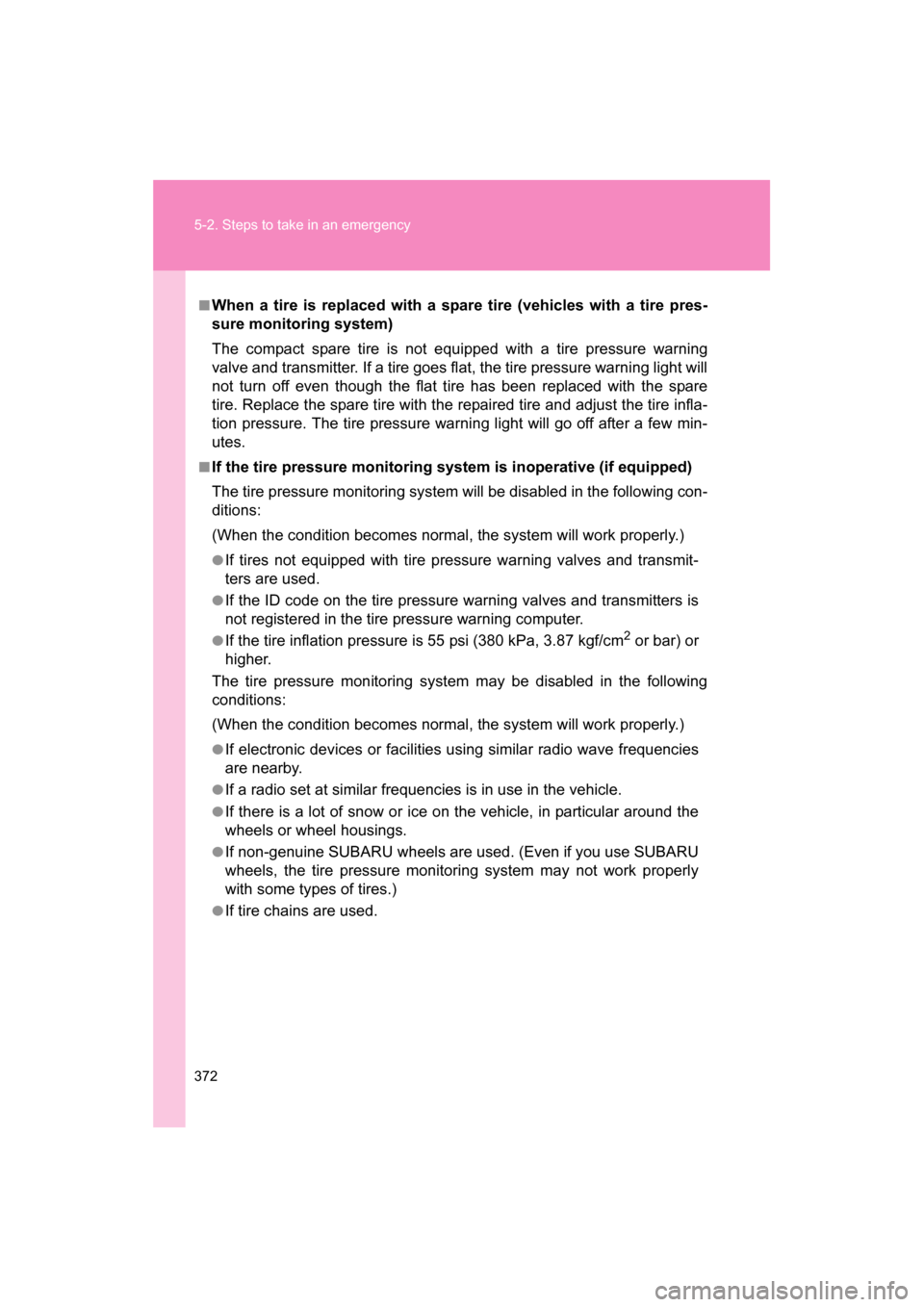
372
5-2. Steps to take in an emergency
■When a tire is replaced with a spare tire (vehicles with a tire pres-
sure monitoring system)
The compact spare tire is not equipped with a tire pressure warning
valve and transmitter. If a tire goes flat, the tire pressure warning light will
not turn off even though the flat tire has been replaced with the spare
tire. Replace the spare tire with the repaired tire and adjust the tire infla-
tion pressure. The tire pressure warning light will go off after a few min-
utes.
■If the tire pressure monitoring system is inoperative (if equipped)
The tire pressure monitoring system will be disabled in the following con-
ditions:
(When the condition becomes normal, the system will work properly.)
●If tires not equipped with tire pressure warning valves and transmit-
ters are used.
●If the ID code on the tire pressure warning valves and transmitters is
not registered in the tire pressure warning computer.
●If the tire inflation pressure is 55 psi (380 kPa, 3.87 kgf/cm 2
or bar) or
higher.
The tire pressure monitoring system may be disabled in the following
conditions:
(When the condition becomes normal, the system will work properly.)
●If electronic devices or facilities using similar radio wave frequencies
are nearby.
●If a radio set at similar frequencies is in use in the vehicle.
●If there is a lot of snow or ice on the vehicle, in particular around the
wheels or wheel housings.
●If non-genuine SUBARU wheels are used. (Even if you use SUBARU
wheels, the tire pressure monitoring system may not work properly
with some types of tires.)
●If tire chains are used.
Page 402 of 488
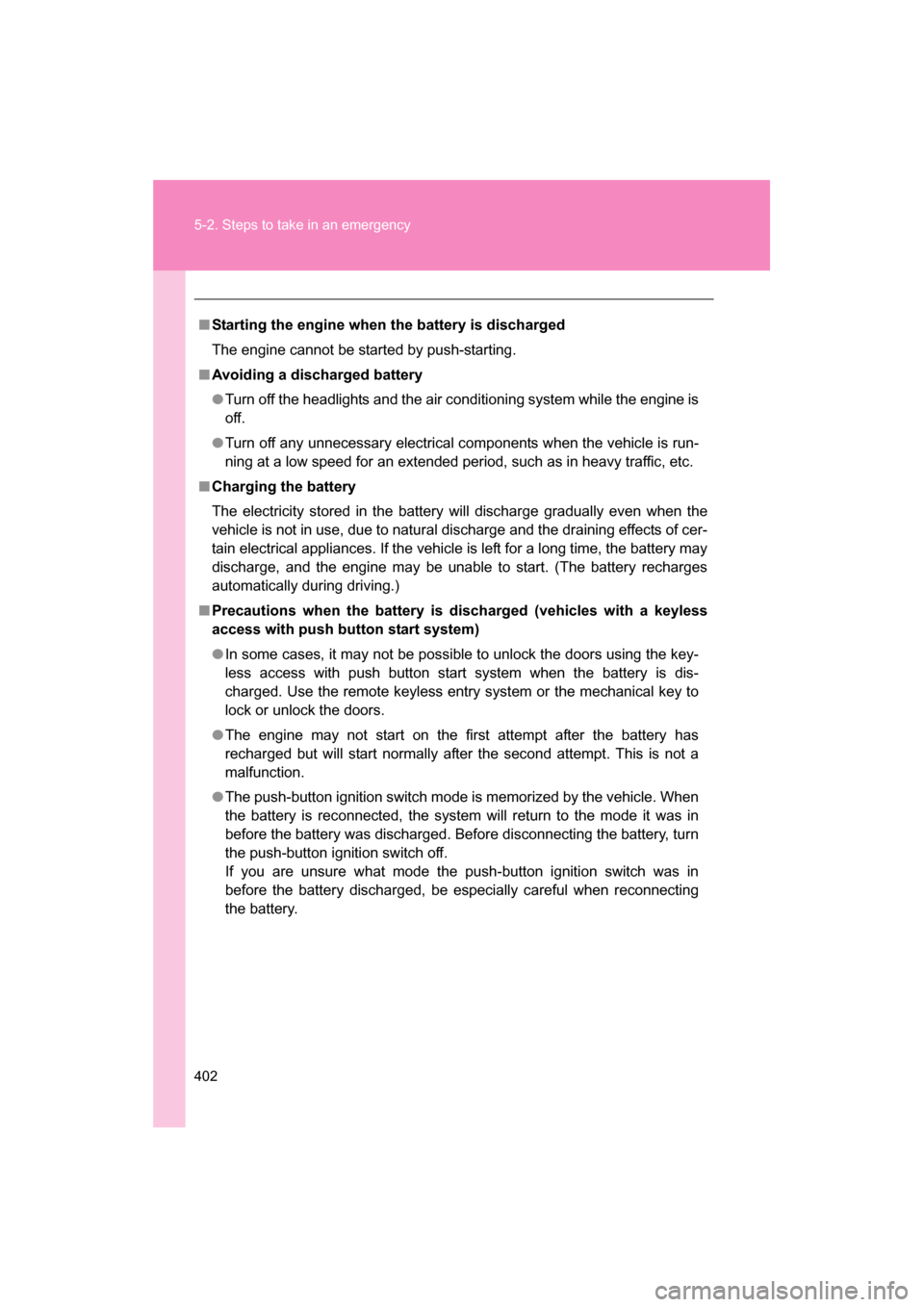
402
5-2. Steps to take in an emergency
■Starting the engine when the battery is discharged
The engine cannot be started by push-starting.
■Avoiding a discharged battery
●Turn off the headlights and the air conditioning system while the engine is
off.
●Turn off any unnecessary electrical components when the vehicle is run-
ning at a low speed for an extended period, such as in heavy traffic, etc.
■Charging the battery
The electricity stored in the battery will discharge gradually even when the
vehicle is not in use, due to natural discharge and the draining effects of cer-
tain electrical appliances. If the vehicle is left for a long time, the battery may
discharge, and the engine may be unable to start. (The battery recharges
automatically during driving.)
■Precautions when the battery is discharged (vehicles with a keyless
access with push button start system)
●In some cases, it may not be possible to unlock the doors using the key-
less access with push button start system when the battery is dis-
charged. Use the remote keyless entry system or the mechanical key to
lock or unlock the doors.
●The engine may not start on the first attempt after the battery has
recharged but will start normally after the second attempt. This is not a
malfunction.
●The push-button ignition switch mode is memorized by the vehicle. When
the battery is reconnected, the system will return to the mode it was in
before the battery was discharged. Before disconnecting the battery, turn
the push-button ignition switch off.
If you are unsure what mode the push-button ignition switch was in
before the battery discharged, be especially careful when reconnecting
the battery.
Page 434 of 488
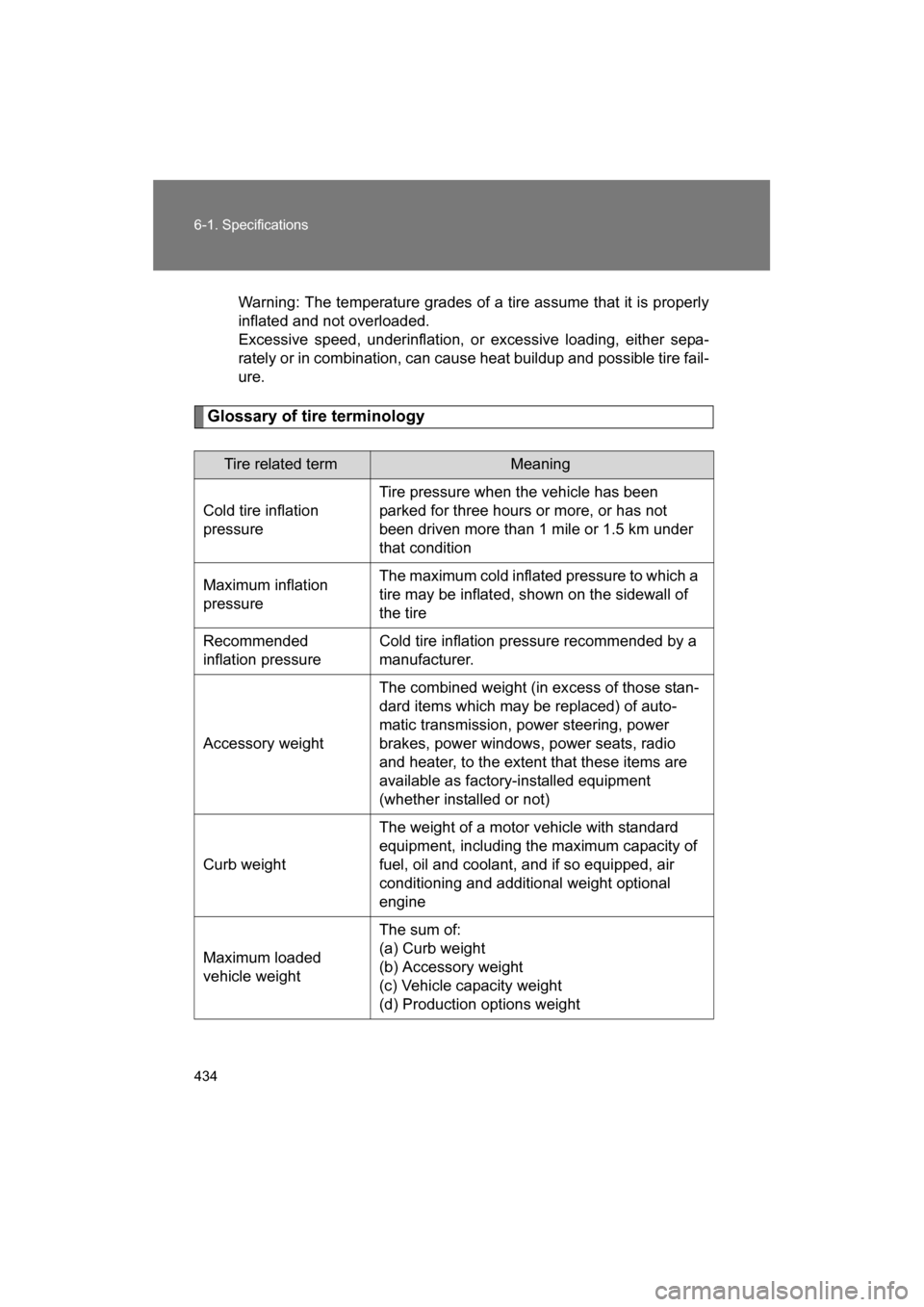
434
6-1. Specifications
Warning: The temperature grades of a tire assume that it is properly
inflated and not overloaded.
Excessive speed, underinflation, or excessive loading, either sepa-
rately or in combination, can cause heat buildup and possible tire fail-
ure.
Glossary of tire terminology
Tire related termMeaning
Cold tire inflation
pressure Tire pressure when the vehicle has been
parked for three hours or more, or has not
been driven more than 1 mile or 1.5 km under
that condition
Maximum inflation
pressure The maximum cold inflated pressure to which a
tire may be inflated, shown on the sidewall of
the tire
Recommended
inflation pressure Cold tire inflation pressure recommended by a
manufacturer.
Accessory weight The combined weight (in excess of those stan-
dard items which may be replaced) of auto-
matic transmission, power steering, power
brakes, power windows, power seats, radio
and heater, to the extent that these items are
available as factory-installed equipment
(whether installed or not)
Curb weight The weight of a motor vehicle with standard
equipment, including the maximum capacity of
fuel, oil and coolant, and if so equipped, air
conditioning and additional weight optional
engine
Maximum loaded
vehicle weight The sum of:
(a) Curb weight
(b) Accessory weight
(c) Vehicle capacity weight
(d) Production options weight
Page 459 of 488
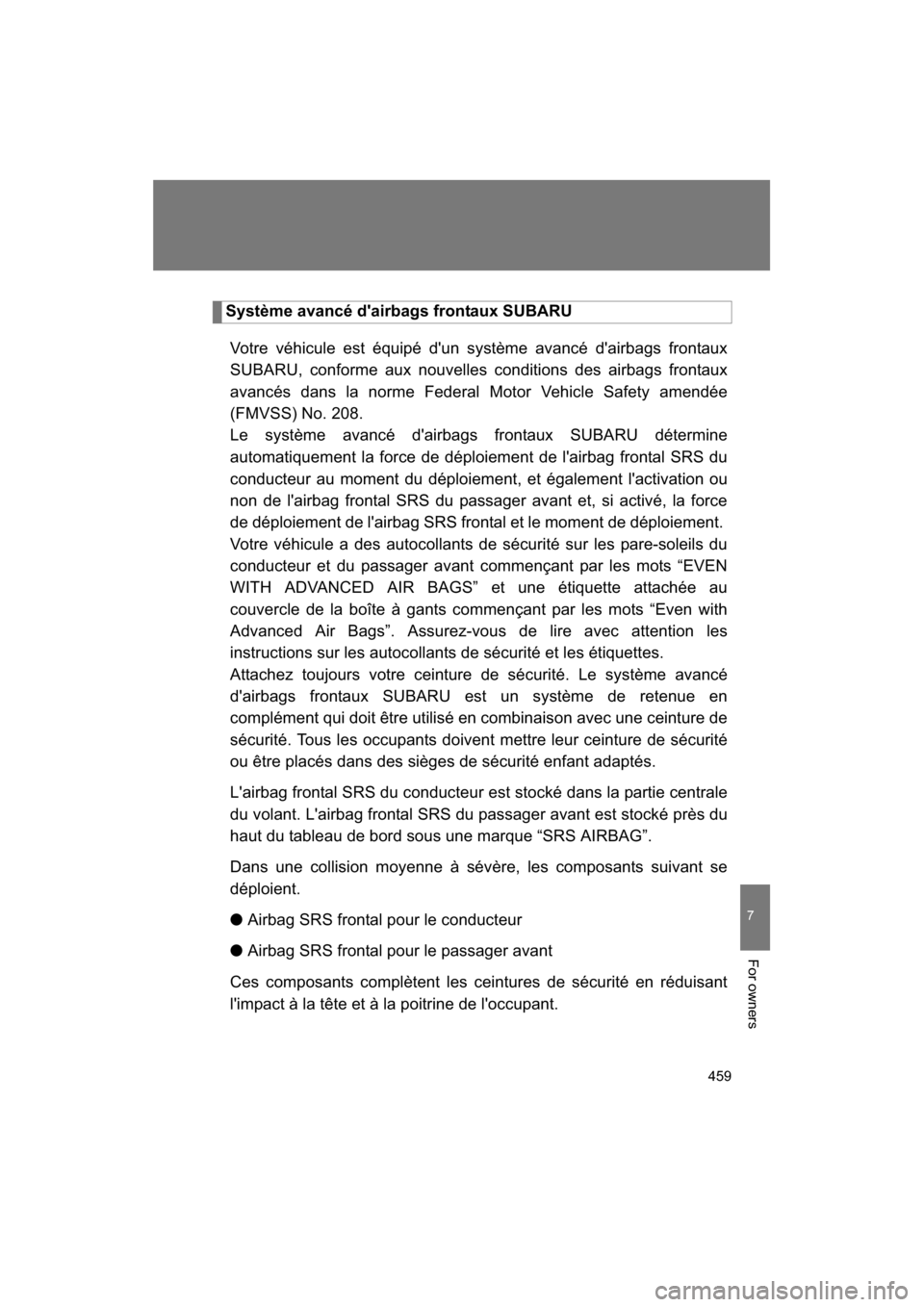
459
7
For owners
Système avancé d'airbags frontaux SUBARUVotre véhicule est équipé d'un système avancé d'airbags frontaux
SUBARU, conforme aux nouvelles conditions des airbags frontaux
avancés dans la norme Federal Motor Vehicle Safety amendée
(FMVSS) No. 208.
Le système avancé d'airbags frontaux SUBARU détermine
automatiquement la force de déploiement de l'airbag frontal SRS du
conducteur au moment du déploiement, et également l'activation ou
non de l'airbag frontal SRS du passager avant et, si activé, la force
de déploiement de l'airbag SRS frontal et le moment de déploiement.
Votre véhicule a des autocollants de sécurité sur les pare-soleils du
conducteur et du passager avant commençant par les mots “EVEN
WITH ADVANCED AIR BAGS” et une étiquette attachée au
couvercle de la boîte à gants commençant par les mots “Even with
Advanced Air Bags”. Assurez-vous de lire avec attention les
instructions sur les autocollants de sécurité et les étiquettes.
Attachez toujours votre ceinture de sécurité. Le système avancé
d'airbags frontaux SUBARU est un système de retenue en
complément qui doit être utilisé en combinaison avec une ceinture de
sécurité. Tous les occupants doivent mettre leur ceinture de sécurité
ou être placés dans des sièges de sécurité enfant adaptés.
L'airbag frontal SRS du conducteur est stocké dans la partie centrale
du volant. L'airbag frontal SRS du passager avant est stocké près du
haut du tableau de bord sous une marque “SRS AIRBAG”.
Dans une collision moyenne à sévère, les composants suivant se
déploient. ● Airbag SRS frontal pour le conducteur
● Airbag SRS frontal pour le passager avant
Ces composants complètent les ceintures de sécurité en réduisant
l'impact à la tête et à la poitrine de l'occupant.
Page 470 of 488
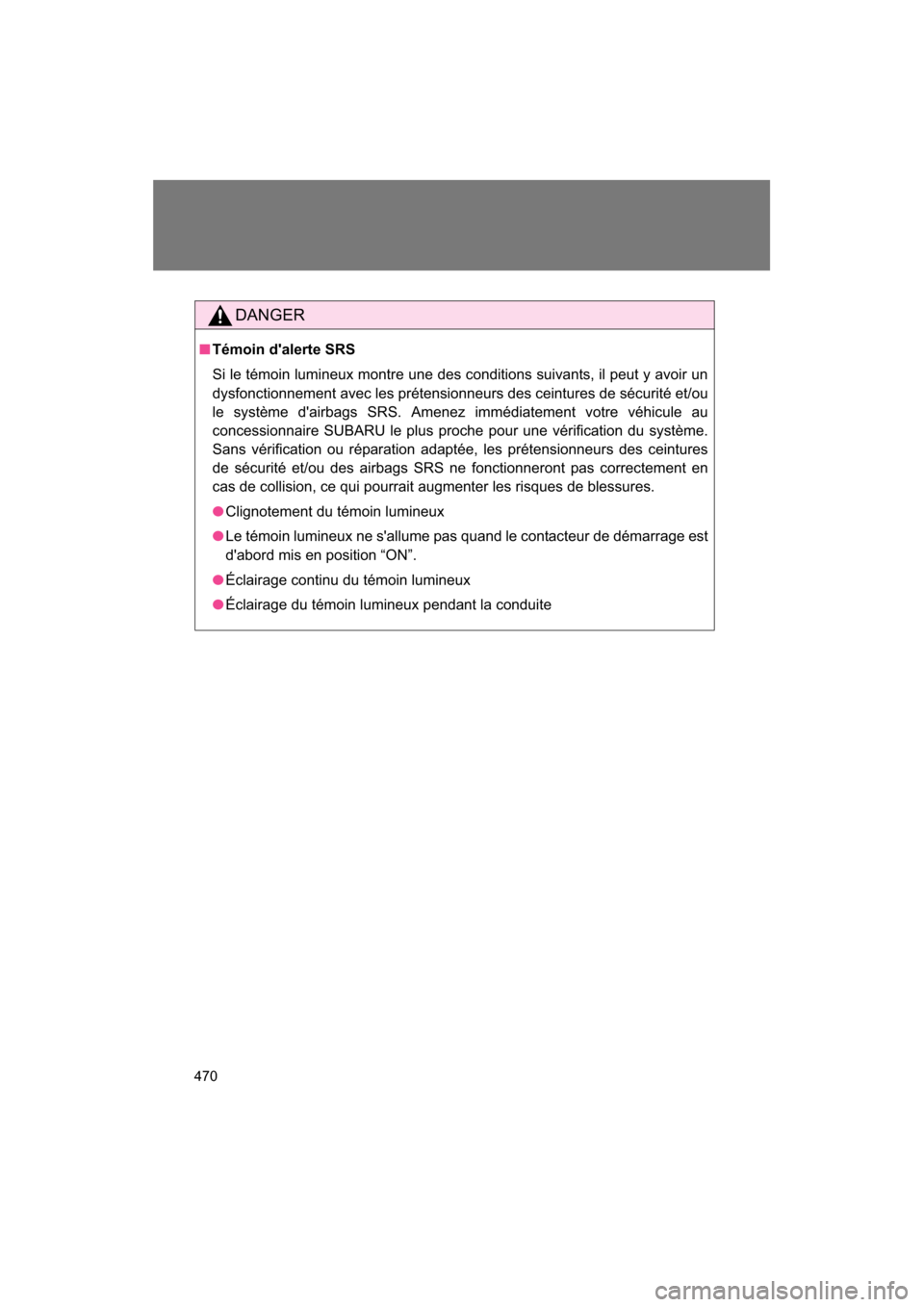
470
DANGER
■Témoin d'alerte SRS
Si le témoin lumineux montre une des conditions suivants, il peut y avoir un
dysfonctionnement avec les prétensionneurs des ceintures de sécurité et/ou
le système d'airbags SRS. Amenez immédiatement votre véhicule au
concessionnaire SUBARU le plus proche pour une vérification du système.
Sans vérification ou réparation adaptée, les prétensionneurs des ceintures
de sécurité et/ou des airbags SRS ne fonctionneront pas correctement en
cas de collision, ce qui pourrait augmenter les risques de blessures.
●Clignotement du témoin lumineux
●Le témoin lumineux ne s'allume pas quand le contacteur de démarrage est
d'abord mis en position “ON”.
●Éclairage continu du témoin lumineux
●Éclairage du témoin lumineux pendant la conduite
Page 473 of 488
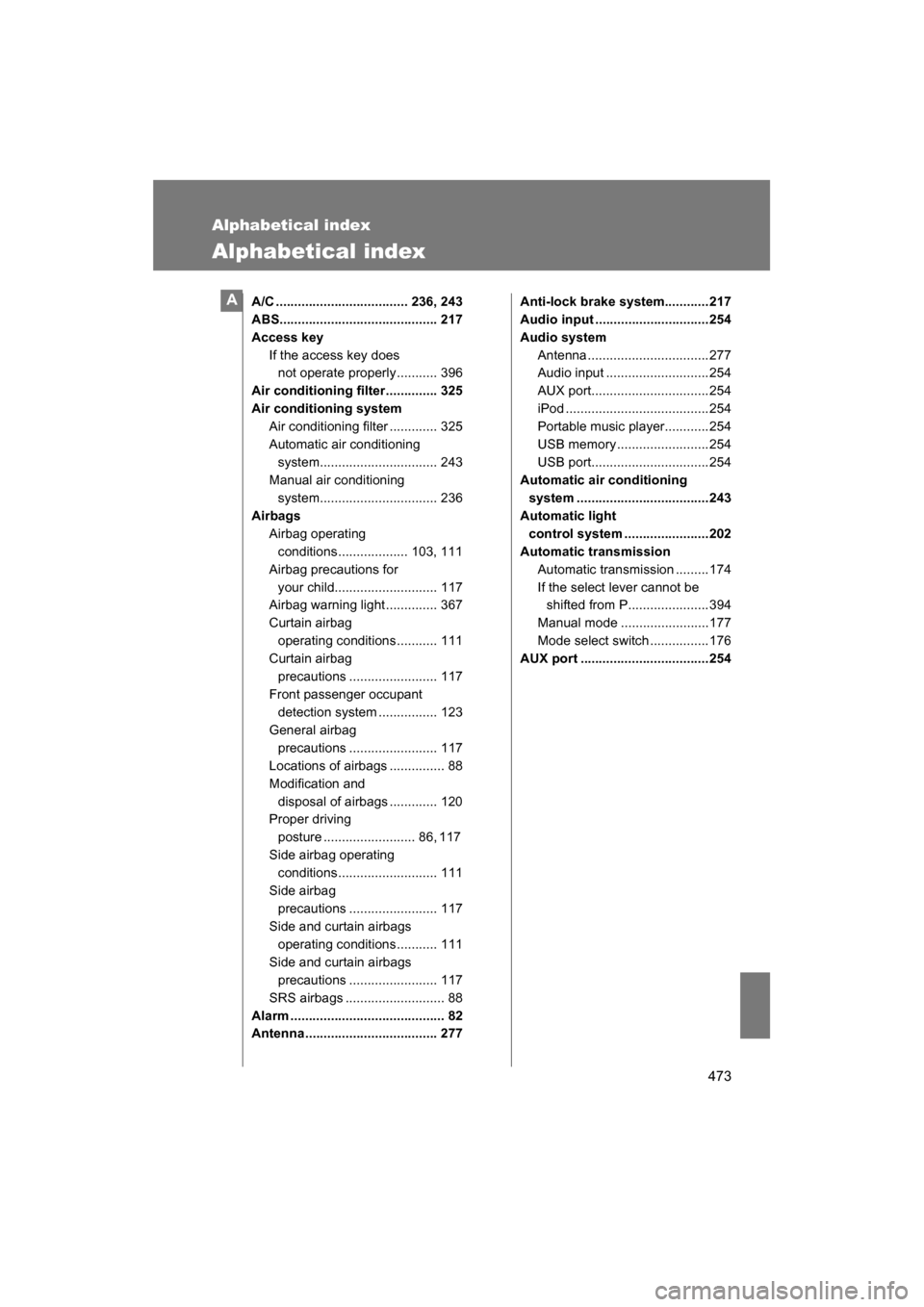
473
Alphabetical index
Alphabetical index
A/C .................................... 236, 243
ABS........................................... 217
Access keyIf the access key does not operate properly........... 396
Air conditioning filter.............. 325
Air conditioning system Air conditioning filter ............. 325
Automatic air conditioning
system................................ 243
Manual air conditioning system................................ 236
Airbags Airbag operating
conditions................... 103, 111
Airbag precautions for your child............................ 117
Airbag warning light .............. 367
Curtain airbag
operating conditions........... 111
Curtain airbag precautions ........................ 117
Front passenger occupant detection system ................ 123
General airbag precautions ........................ 117
Locations of airbags ............... 88
Modification and disposal of airbags ............. 120
Proper driving
posture ......................... 86, 117
Side airbag operating conditions........................... 111
Side airbag precautions ........................ 117
Side and curtain airbags
operating conditions........... 111
Side and curtain airbags precautions ........................ 117
SRS airbags ........................... 88
Alarm .......................................... 82
Antenna .................................... 277 Anti-lock brake system............217
Audio input ...............................254
Audio system
Antenna .................................277
Audio input ............................254
AUX port................................254
iPod .......................................254
Portable music player............254
USB memory .........................254
USB port................................254
Automatic air conditioning system ....................................243
Automatic light control system .......................202
Automatic transmission Automatic transmission .........174
If the select lever cannot be shifted from P......................394
Manual mode ........................177
Mode select switch ................176
AUX port ...................................254A